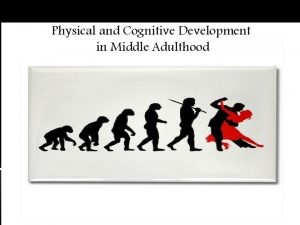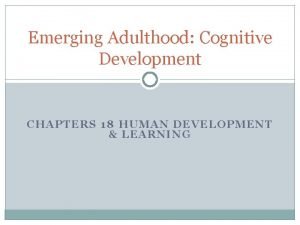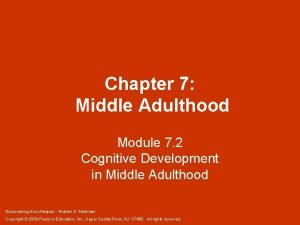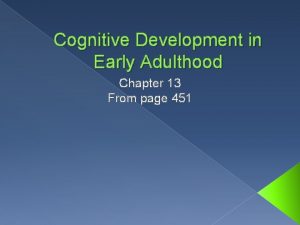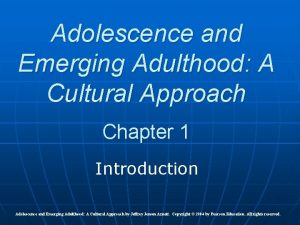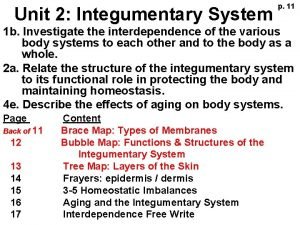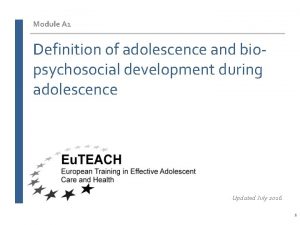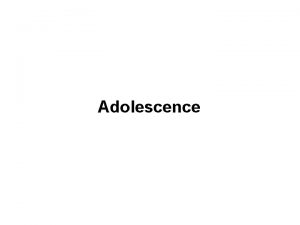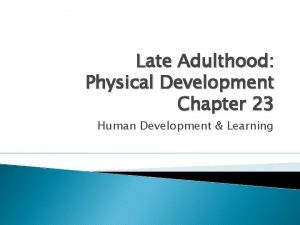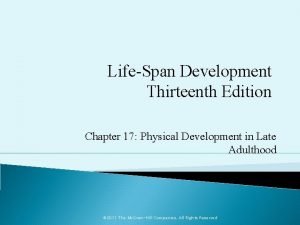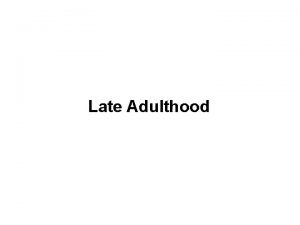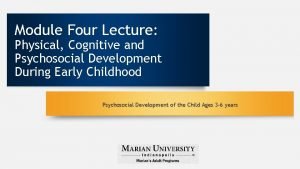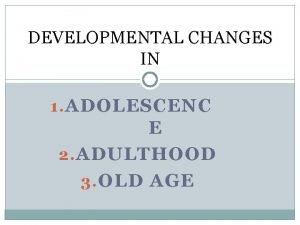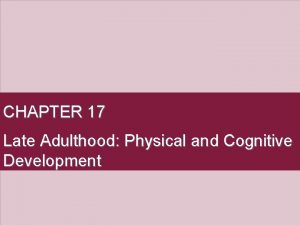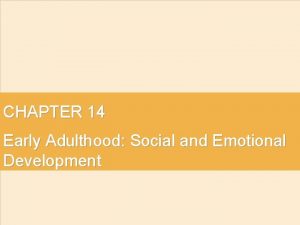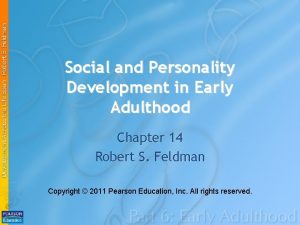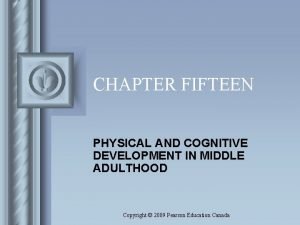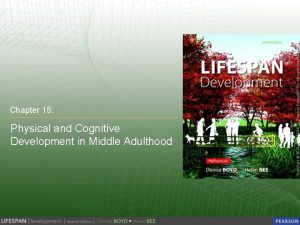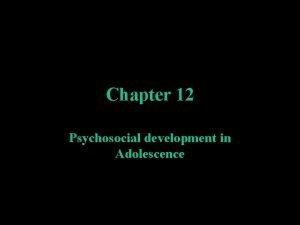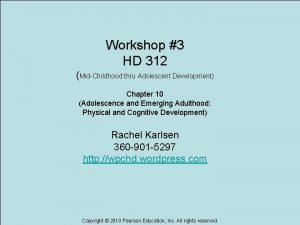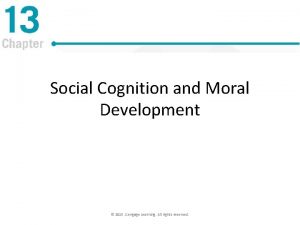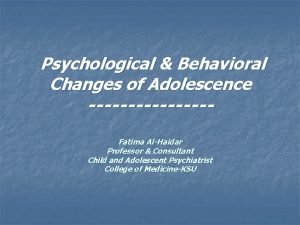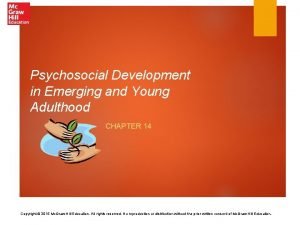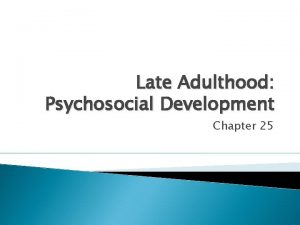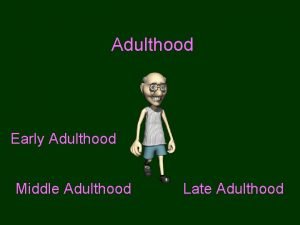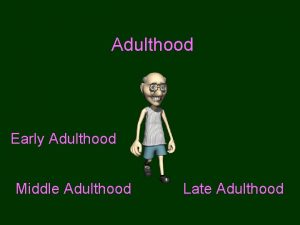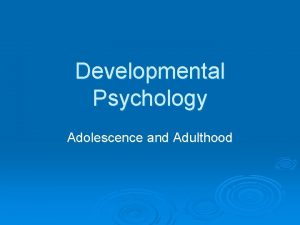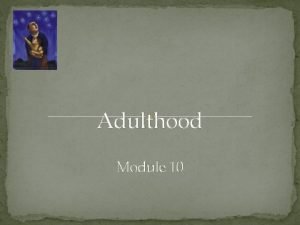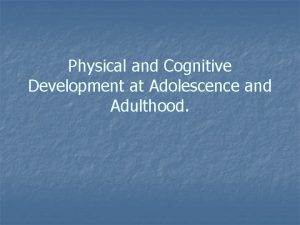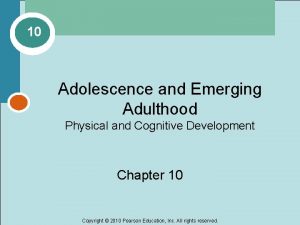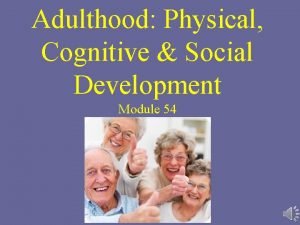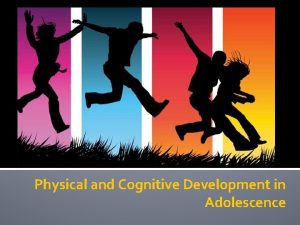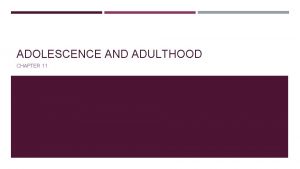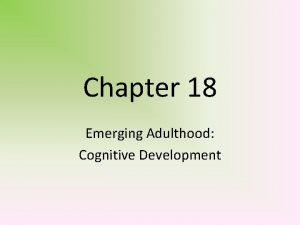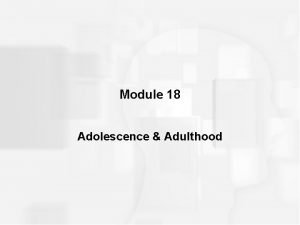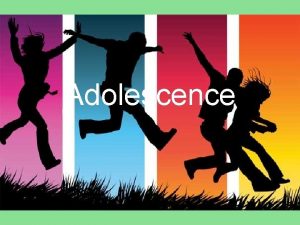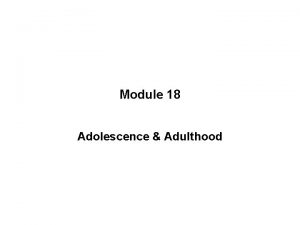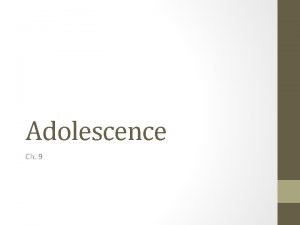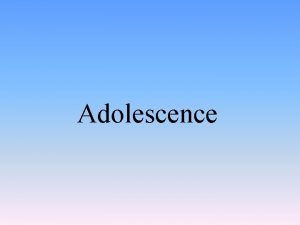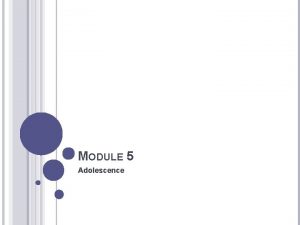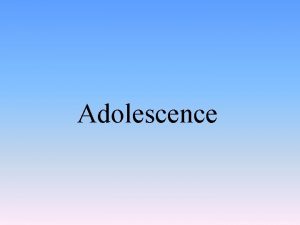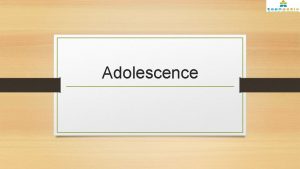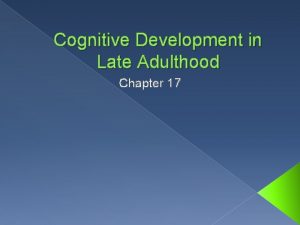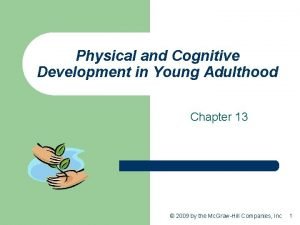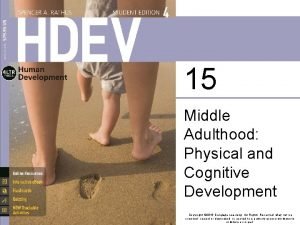Adolescence and Adulthood Adolescence Physical Development Cognitive Development


































- Slides: 34

Adolescence and Adulthood

Adolescence § Physical Development § Cognitive Development § Social Development § Emerging Adulthood § Thinking About Continuity and Stages

Adolescence Adolesence is the period of transition between childhood and adulthood. It begins with puberty, the period of sexual maturation.

Physical Development • Puberty begins at about age 11 in girls and age 13 in boys • Menarche, a girl’s first menstrual cycle, usually occurs around age 12 • Spermarche, a boy’s first ejaculation, occurs around age 14 • Girls have earlier growth spurt, then by age 14, boys on average become taller than girls

Physical Development: The Brain • Adolescent brains: frontal lobe maturation lags behind the emotional limbic system’s development – Teens are impulsive, emotional, and prone to risky behaviors • Frontal lobes continue to develop until about age 25

Cognitive Development • During early teens, reasoning is self-focused • Already able to think about other’s states of mind, a teenage girl might start to picture boys wondering about her thoughts • Abstract reasoning gradually develops (Piaget’s formal operations stage)

Developing Reasoning Power Adolescents can judge good from evil, truth and justice, and think about God in deeper terms. Adolescents can handle abstract logic, and can find hypocrisy and other flaws in the thoughts and actions of others. They become more interested in moral, ethical, philosophical and religious questions and may fight for political ideals.

Developing Morality

Changes in Nature of Morality As our thinking matures, so does our behavior in that we become less selfish and more caring. People who engage in doing the right thing develop empathy for others and the self-discipline to resist their own impulses. People change in what motivates their moral choices. In Kohlberg’s model, people move from seeking rewards to seeking approval to following ethical ideals.

Critism of Kohlberg • “Postconventional morality” stage occurs mostly in individualistic cultures – among North American and European upper and middle classes. • Kohlberg’s theory may be biased against collectivist societies


Forming an Identity • In Western cultures, many adolescents try out different “selves” to refine their sense of identity • Can become confusing when worlds intersect – “Which is the real me? ”

Forming an Identity • Social identity: the “we” aspect of our self-concept, that comes from our group memberships – Can become confusing when worlds intersect – “Which is the real me? ” (role confusion) – Often formed by how we differ from those around us - we may feel more “American” when spending time abroad • Erikson believed that adolescent identity stage is followed by developing a capacity for intimacy – the ability to form emotionally close relationships. The alternative: isolation

Parent and Peer Relationships • Teens get their culture from their peers – Adolescents adopt peer accent/language over parents’ – Teens adopt peer habits such as smoking, and seek others with the same habits • Relationship with parents and with peers have a similar style • Parents are still an important influence in religion, career, and political views

Emerging Adulthood In Western Cultures, there seem to be people beyond adolescence who are not yet fully independent adults. This corresponds with a larger age span between menarche and marriage (below):

Thinking about Continuity and Stages • Life is more complicated than implied by neatly-defined stages • The concept of the stage is still useful

The Stages Zoomed In

The Stages Zoomed In

The Stages Zoomed In

Adulthood § Physical Development § Cognitive Development § Social Development § Thinking About Stability and Change

Adulthood • Defining stages in adulthood is more difficult than doing so for childhood and adolescence • Still, these terms are useful: – Early adulthood (20 s and 30 s) – Middle adulthood (to age 65) – Late adulthood (65+)

Young Adulthood: Physical Development The peak of physical performance occurs by early to mid-twenties, after which it declines imperceptibly for most of us.

Physical Development: Middle Adulthood • Muscular strength, reaction time, sensory abilities and cardiac output begin to decline after the mid-20 s.

Physical Development: Later Middle Adulthood Around age 50, women experience menopause (the end of the menstrual cycle) and men experience a gradual decline in fertility and virility.

Physical Development: Late Adulthood (65+) • Hearing, vision, and sense of smell diminish, as do muscle strength, reaction time, and stamina.

Aging Cognitive Development • Neural processing slows in late adulthood – Slower reaction time • Some aspects of memory also decline – Decline in recall of recently memorized words – No decline in ability to recognize recently learned words

Aging and Intelligence • Crystallized intelligence – one’s accumulated knowledge, increases into middle age • Fluid intelligence – the ability to reason speedily and abstractly, decreases slowly up to about age 75, then more rapidly • Mental practice and physical exercise can help sustain cognitive skills

Social Development • Two basic aspects of our lives dominate adulthood. • Erikson called them intimacy (forming close relationships) and generativity (being productive and supporting future generations). • Freud: The healthy adult is one who can love and work.

Adulthood Commitments: Relationships Evolutionary psychologists believe that commitment has survival value. Parents that stay together are likely to leave a viable future generation.

Adulthood Commitments: Work • Happiness stems from working in a job that fits your interests and provides you with a sense of competence and accomplishment.

The Social Clock • Like the Biological Clock, this is the culturallybased expectation about when you should leave home, marry, start a career, have children, retire • People today may feel more free to make their own timelines rather than obey the clock

Death and Dying • Death and Dying: Impact on survivors • Grief is more intense if someone died young, unexpectedly • Style of grieving varies, with no “right” sequence or process • People do rebound from loss (chart)

Well-Being Across the Life Span • Happiness does not decrease with age • Older adults show less response to negative events and information • Positive feelings remain, negative feelings fade

Stability and Change Lifelong development includes both stability and change. Basic temperament seems to persist; a smiley grandparent was probably once a smiley baby. Traits such as conscientiousness, confidence, and agreeableness tend to evolve with age and then stabilize as part of one’s personality. The tendency toward stability gives us a sense of identity. The potential for change gives us the hope of personal growth: Growing older can mean getting better.
 Physical and cognitive development in early adulthood
Physical and cognitive development in early adulthood Labouvie-vief pragmatic thought
Labouvie-vief pragmatic thought Middle adulthood cognitive development
Middle adulthood cognitive development Intellectual development in later adulthood
Intellectual development in later adulthood Postformal thought
Postformal thought Cognitive development middle adulthood
Cognitive development middle adulthood Commitment within relativistic thinking
Commitment within relativistic thinking Adolescence and emerging adulthood a cultural approach
Adolescence and emerging adulthood a cultural approach Infancy childhood adolescence adulthood old age
Infancy childhood adolescence adulthood old age Middle adolescence physical development
Middle adolescence physical development Physical development during adolescent
Physical development during adolescent Filial maturity
Filial maturity Physical development in late adulthood
Physical development in late adulthood Physical changes in middle adulthood
Physical changes in middle adulthood Physical development in late adulthood
Physical development in late adulthood Late adulthood physical development
Late adulthood physical development Define physical cognitive and psychosocial development
Define physical cognitive and psychosocial development Cognitive and non cognitive religious language
Cognitive and non cognitive religious language Main characteristics of adolescence
Main characteristics of adolescence Changes in late adulthood
Changes in late adulthood Slidetodoc. com
Slidetodoc. com Examples of social development in middle adulthood
Examples of social development in middle adulthood Social and emotional development in adulthood
Social and emotional development in adulthood Personality development in early adulthood
Personality development in early adulthood Socioemotional development in late adulthood
Socioemotional development in late adulthood Denny's model of physical and cognitive ageing
Denny's model of physical and cognitive ageing Denny's model of physical and cognitive ageing
Denny's model of physical and cognitive ageing Brain development adolescence
Brain development adolescence Moral development in adolescence
Moral development in adolescence Psychosocial development in adolescence
Psychosocial development in adolescence Moral development in adolescence
Moral development in adolescence Moral development in adolescence
Moral development in adolescence Emotional development in adolescence
Emotional development in adolescence Psychosocial development in young adulthood
Psychosocial development in young adulthood Late adulthood psychosocial development
Late adulthood psychosocial development


